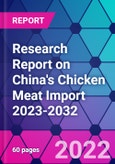In 2021, China imported 1.5 million tons of chicken meat (including whole chickens, chicken cuts, wing of chicken, chicken claw, offal of chicken, the same below), down 4.2% year-on-year, with imports of US$3.5 billion, up 0.6% year-on-year. According to The publisher analysis, in the first three quarters of 2022, China imported 1.004 million tons of chicken meat, down 6.1% year-on-year, with imports of US$3.1 billion, up 24.5% year-on-year.
In 2018-2021, the average price of China's chicken meat imports is relatively stable, generally remaining in the price range of US$2.2-2.5 per kg. in 2022, the price of China's chicken meat imports rises to US$3.0 per kg, up 32.7% year-on-year.
In 2021, China imported chicken meat from a total of 10 countries. According to the publisher's analysis, the main sources of China's chicken meat imports by volume are Brazil, the United States, the Russian Federation, Thailand and Argentina, with chicken meat imports from these five countries accounting for more than 95% of total imports in that year. Among them, Brazil is China's largest source of chicken meat imports. 2021, China imported 651,000 tons of chicken meat from Brazil, accounting for 44.5% of the total import volume and US$1.5 billion, accounting for 42.0% of the total import value.
The publisher analyzes that China's chicken meat imports are mainly frozen chicken meat. Among the various types of frozen chicken meat, frozen chicken claws, frozen chicken wings, frozen chicken pieces with bones and frozen chicken offal are the main types of imports. According to the publisher's analysis, frozen chicken claws are the largest type of chicken meat imported into China. 674,000 tons of frozen chicken claws were imported into China in 2021, accounting for 46.1% of the total import volume and US$1.9 billion, accounting for 55.1% of the total import value.
China is one of the world's major chicken meat consumers, and chicken meat occupies an important position in the country's diet and consumption structure. The publisher forecasts that China's chicken meat imports are expected to continue to rise from 2023-2032.
Topics covered:
- China's Chicken Meat Import Status and Major Sources in 2018-2022
- What is the Impact of COVID-19 on China's Chicken Meat Import?
- Which Companies are the Major Players in China's Chicken Meat Import Market and What are their Competitive Benchmarks?
- Key Drivers and Market Opportunities in China's Chicken Meat Import
- What are the Key Drivers, Challenges, and Opportunities for China's Chicken Meat Import during 2023-2032?
- What is the Expected Revenue of China's Chicken Meat Import during 2023-2032?
- What are the Strategies Adopted by the Key Players in the Market to Increase Their Market Share in the Industry?
- What are the Competitive Advantages of the Major Players in China's Chicken Meat Import Market?
- Which Segment of China's Chicken Meat Import is Expected to Dominate the Market in 2032?
- What are the Major Adverse Factors Facing China's Chicken Meat Import?
Table of Contents
Methodology
Background research defines the range of products and industries, which proposes the key points of the research. Proper classification will help clients understand the industry and products in the report.
Secondhand material research is a necessary way to push the project into fast progress. The analyst always chooses the data source carefully. Most secondhand data they quote is sourced from an authority in a specific industry or public data source from governments, industrial associations, etc. For some new or niche fields, they also "double-check" data sources and logics before they show them to clients.
Primary research is the key to solve questions, which largely influence the research outputs. The analyst may use methods like mathematics, logical reasoning, scenario thinking, to confirm key data and make the data credible.
The data model is an important analysis method. Calculating through data models with different factors weights can guarantee the outputs objective.
The analyst optimizes the following methods and steps in executing research projects and also forms many special information gathering and processing methods.
1. Analyze the life cycle of the industry to understand the development phase and space.
2. Grasp the key indexes evaluating the market to position clients in the market and formulate development plans
3. Economic, political, social and cultural factors
4. Competitors like a mirror that reflects the overall market and also market differences.
5. Inside and outside the industry, upstream and downstream of the industry chain, show inner competitions
6. Proper estimation of the future is good guidance for strategic planning.

LOADING...








